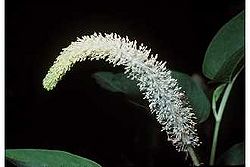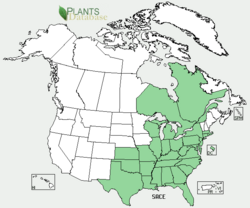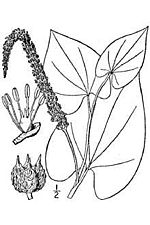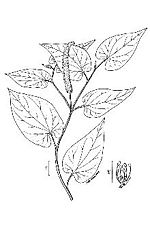Lizard's tail
| Lizard's tail |
|---|

|
| Scientific Classification |
|
| Binomial Name |
|
Saururus cernuus |
| Image Description |
Lizard's tail or water dragon is a species of aquatic plant given the scientific name Saururus cernuus. They have a long, fuzzy stem and a spike-shape flower structure with beautiful white blooms that soon wrinkle giving it it a lizard's tail–like appearance. It can reproduce both sexually and asexually and are commonly found in colonies in marsh land. It provides a habitat for many invertebrates and can also be used as a food source after it’s death and decomposition.
It takes up much of the Eastern United States and parts of Canada. It can also be used for certain medicinal purposes. It's orange scent can attract birds and it repels deer. It can withstand up to 4 inches of water so it can help control the water level in it's environment.
Anatomy
The Lizard’s tail is a perennial plant that can grow up to four feet. It has a stiff, fuzzy stem with little or no branches. The leaves are attached to a short petiole and have a lace to heart shaped form. The leaves are generally 2 to 5 inches long by 1 to 3 inches wide. They alternate with veins that come together at the base.[1]
The flowers bloom on a long, fuzzy stem, opposite to the uppermost leaf. This flowering structure is composed of a spike of many small whitish flowers that forms a curving, tail-like shape. As the seeds develop the tail begins to look wrinkled and green (due to the seeds), thus the name Lizard’s tail.[2] This aquatic plant has rhizomes and a fibrous roots and it is normally emerged in water. [3] It also has a distinct orange-like scent. [4]
Reproduction
The plant reproduces by runners [5], face down, above ground stems, also called stolons. They are important organs for the vegetative reproduction process. [6] These runners grow in clusters or bulky stands and commonly form colonies. These runners produce flowers that dangle in lengthy, slim, bending spikes. They are normally colored white or yellowish-white.[7]
These flowers bloom from June and stay around until September. After these flowers have bloomed fruits begin to grow into long, bunches of brown capsules that resemble the scaly tail of a lizard.[8] These bunches of capsules are actually carpels. [9] Carpels are structures of the Pistil, the female reproductive part of the plant. It is a special ovule-bearing leaf. The rootsystem of each ovum is abundant in rhizomes which allows vegetative reproduction to be possible. [10] Sexual Reproduction also occurs. The pollen is released when it is touched by an insect or moved by wind. [11]
Ecology
Saururus cernuus, also know as, the Water Dragon is an aquatic plant that helps provide a habitat for many invertebrates located in marshes, streams, and ponds. By housing these invertebrates it provides a food source for larger animals. It even helps its environment after its death. It is decomposed by bacteria and fungi and becomes food, called detritus, for many aquatic invertebrates. However it is unknown if it has any direct food value to its fauna. [12]
This plant is normally found in clusters due to vegetative reproduction by runners or stolons. This plant is also quite wide-spread because it is not limited to one specific water type due to its high tolerance of pH levels. It can be found in most of the Eastern United States. It can even be found in Southern Canada, Michigan, Minnesota, and even central Florida. It can grow in both salt and fresh water; giving it a large range to spread. [13]
Benefits
The most obvious benefit of having a Lizard’s tail plant is for ornamental uses. It has striking flowers and can be used in ponds and bogs on real estate. It is also useful for wood ducks in their environment. The young shoots and leaves can provide food for cattle and sheep. (May be toxic if eaten in large quantities) Its fragrant flowers can attract many birds, which add excitement to any environment. It is also extremely deer resistant so you can preserve your plants and land. It was also used to treat inflammation, especially of the mammary glands. [14]
It can also use a lot of water, so if you live in an area that easily floods it can help maintain the water level. It can stay in soil up to 4 inches below the water. The lizard tail grows well in shady environments, so if you do not have much sun it will flourish. Its foliage can also be crushed to create a nice aroma. [15]
References
- Lizard's Tail Aquaplant Texas Agrilife Extension Service, Department of Wildlife and Fisheries Sciences, Texas A&M University
- Lizard's Tail: Saururus cernuus Virginia Tech Weed Identification Guide
- Lizard's tail (Saururus cernuus) University of Florida Institute of Food and Agricultural Sciences, Florida Forest Plants
- Vegetative reproduction Wikipedia, The Free Encyclopedia, multiple authors
- Saururus cernuus L. Lizards tail Encyclopedia of Life Species recognized by T Orrell (custodian),
- CarpelThe American Heritage® Dictionary of the English Language, Fourth Edition copyright ©2000 by Houghton Mifflin Company. Updated in 2003. Published by Houghton Mifflin Company. All rights reserved.
- Population Structure and Reproductive Biology of Saururus cernuus L. (Saururaceae)Wiley InterScience LEONARD B. THIEN 1) , ERIK G. ELLGAARD 1) , MARGARET S. DEVALL 2) , SARA E. ELLGAARD 1) PAUL F. RAMP 3)
- Saururus cernuus L.Lady Bird Johnson Wildflower Center, The University of Texas at Austin



